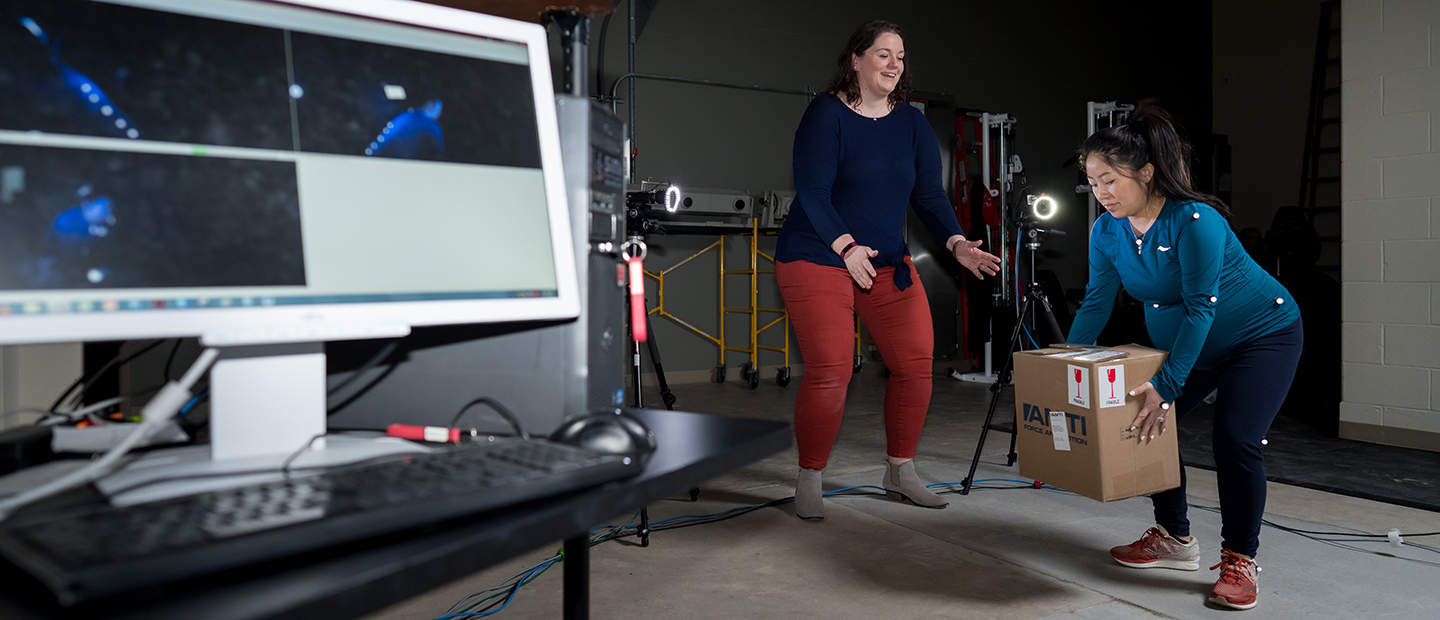
Biomechanics Ergonomics and Abilities Research (BEAR) Lab
The Biomechanics Ergonomics and Abilities Research (BEAR) Lab focuses on developing knowledge and methods to support patient-centered physical medicine. Comprised of a multidisciplinary group of researchers across the School of Health Sciences, expert faculty work in close collaboration with undergraduate and graduate students to achieve advances in health monitoring and care delivery.
The state-of-the-art space is designed and equipped to measure, monitor, and modify various aspects of mobility and state of mind, utilizing IR and markerless 3D motion tracking, force plates, EMG, eye tracking and computer-vision based affect assessment. Current research projects include experimental studies examining osteoarthritis, cancer survivorship, autism, work-related health of older workers and special populations, posture and injury risk, and athletic performance.
Visit the BEAR Lab website to learn more about the BEAR Lab and what our students have been working on.
The mission of the BEAR Lab is to discover, develop and sustain a multidisciplinary academic and research agenda in the area of human movement. Driven by endless curiosity, we aim to ultimately improve quality of life. We apply biomechanical principles through rigorous investigations of ergonomics (adjusting the environment to suit the capabilities of the individual) and abilities (the capabilities of an individual within a given environment).
Goals:
- To share ideas and develop innovative solutions in addressing issues related to human movement.
- To help others attain optimal human movement.
- To identify features of movement that help us understand pain and mobility limitations.
- To gain a greater understanding of the impact of environmental and human factors on the risk of falls and injury.
- To develop screening tools that recognize gait impairments as well as performance monitoring.
- To improve the patient-provider relationship by revealing “truths” about pain state and empathetic traits.
Please let us know if you're interested in joining the BEAR Lab research team.
Contact us by email at [email protected].
Some specific areas of research performed in the BEAR Lab include:
- Biometrics of Camouflaged Pain and Mobility Limitations in Osteoarthritis
Using balance assessments (via force plate) and visual attention (via eye tracking), along with patient reports of pain and mobility, we seek to create a data-driven method to identify persons who underreport their level of impairment – termed camouflaged pain and mobility limitations. This work includes student led efforts to explore the provider empathy profile and common patient surgical decision criteria.
- Balance and Mobility Impairments in Cancer Survivors
Chemotherapy often induces peripheral neuropathy, which can result in a range of insult including discomfort to sensorimotor impairment. We are exploring the use of balance assessments (via portable force plate) that can be used in clinical and home settings to monitor onset and recovery of balance impairments. Applications of this work include patient-centered customization of treatment and rehabilitation.
- Virtual Learning Technology for Continued Medical Education
We have developed a virtual replica of the physical BEAR Lab in the Unity game engine, for the purpose of laboratory simulation. The goal of this project is to further develop this environment for use in continuing medical education, providing knowledge of biomechanical tools and terminology for physical medicine providers.
- (Re)habilitation Technology for Motor and Social Development
This work includes the development of performance monitoring and behavioral training tools, separately for posture and social cognitive skills.
We are attempting an extension of the BTrackS force plate to operate wirelessly, and at finer resolution for smaller weights, so that postural development of very young children can be monitored more conveniently and accessibly than is otherwise currently possible.
We use eye tracking technology to probe subtle/implicit attentional bias towards images/videos of physically painful experiences, with a goal of better understanding the lived experience of persons with musculoskeletal impairment and the empathy gap that many of these persons feel when interacting with able bodied clinicians.
- Performance Optimization
Using biomechanical techniques, we evaluate novel metrics of performance monitoring and assess the efficacy of training and warm-up strategies to improve performance. This includes novel metrics of the timing of cyclic behavior (e.g. gait patterns) using nonlinear analysis and the use of artificial intelligence to recognize successful movements from webcam monitoring, which combine to support remote and autonomous training.
- Ergonomics in Competitive Gaming
Assessing the discomfort and cognitive demand levels of varsity and club esports players as a result of their game console setup and mental focus across different game systems. Currently, we’re using survey research to gain a better understanding of this environment, but when in-person research is permitted, we will use posture assessments, seat pressure mapping, eye-tracking, and metabolic energy expenditure to gain objective data about the demands placed on these players so that we can make recommendations for training schedules, lifestyle considerations, and furniture setup.
- Training Effectiveness for Preparing Workers to Work from Home
How well does the ergonomics training delivered in the office translate to healthy work habits while working from home? Ergonomics assessment services generally provide feedback about the workstation and adjust it to suit the employee and reduce discomfort. But, if the employee doesn’t know what to watch for specifically, are they able to set up their home office workstation appropriately, or should all employees be given a basic ergonomics overview at regular intervals to make sure that they are informed of best practices to keep themselves safe? Currently, we’re using surveys and image digitization to evaluate the ergonomics of home office workstation as a result of the ergonomics training that the employee received to determine which training approach is most effective in preventing injury.
- The Feasibility and Effectiveness of a Workplace Stretching Program in Manufacturing
According to stretching best practices, we developed an “ideal” workplace stretching program with dynamic stretches in the morning, static stretches in the afternoon, and a yoga-based cooldown at the end of the shift...The problem is getting the workforce and management to buy-in to the program. Factor in the ability of a global pandemic to bring all work to a halt, and bullying behaviors towards those completing their stretches, and you find that incorporating it into the daily routine within a manufacturing facility is an uphill battle.
The BEAR Lab is co-directed by Drs. Diesbourg and Haworth. Along with expert faculty across the School of Health Sciences, the team supervises research of undergraduate and graduate students, and seeks to secure and conduct externally sponsored research projects from public and private entities.
We are grateful for the numerous current and former student collaborators who have been instrumental in the lab’s research endeavors.
Tara Diesbourg, Ph.D., CPE
Dr. Diesbourg is a certified professional ergonomist, and an assistant professor of environmental health and safety in the School of Health Sciences at Oakland University. Her research interests include looking at how the body of special populations function in the workplace, including older, pregnant, obese, or chronically ill individuals. Dr. Diesbourg teaches courses in the areas of ergonomics, regulations, and professional practice.
Daniel Goble, Ph.D.
Dr. Goble is an associate professor of exercise science, and serves as director/coordinator of both the B.S. and M.S. in Exercise Science programs in the School of Health Sciences at Oakland University. His research focuses on the domains of health and disability by objectively measuring balance using portable force plates. Dr. Goble teaches courses in biomechanics and motor control.
Joshua Haworth, Ph.D.
Dr. Haworth is an assistant professor of exercise science in the School of Health Sciences at Oakland University. His research focuses on the integration of sensorimotor information in the production of habitual and volitional human movement behavior. Dr. Haworth teaches courses in biomechanics, integrated laboratory in exercise science, and directed research.
Christian Maron serves as laboratory manager.
School of Health Sciences
3070 Human Health Building
433 Meadow Brook Road
Rochester, MI 48309-4452
(location map)
(248) 370-2369
[email protected]
Dean's Office
Human Health Building
(248) 370-3562
[email protected]







